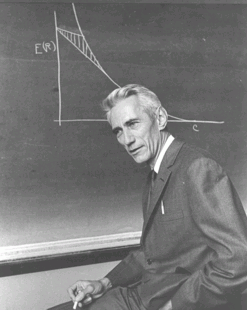This page has moved here.
 |
| Claude Shannon |
“Claude Elwood Shannon is considered as the founding father of [the] electronic communications age,” writes New York University. “While working at Bell Laboratories, he formulated a theory explaining the communication of information and worked on the problem of most efficiently transmitting information”:
Shannon joined Bell Telephone Laboratories as a research mathematician in 1941. He worked on the problem of most efficiently transmitting information. Soon he discovered the similarity between boolean algebra and telephone switching circuits. By 1948, Shannon turned his efforts toward a fundamental understanding of the problem and had evolved a method of expressing information in quantitative form. The fundamental unit of information is a yes-no
situation.i Either something is or is not. This can be easily expressed in Boolean two-value binary algebra by 1 and 0, so that 1 means “on” when the switch is closed and the power is on, and 0 means “off” when the switch is open and power is off. Under these circumstances, 1 and 0 are binary digits, a phrase that can be shortened to “bits.” Thus the unit of information is the bit. A more complicated information can be viewed as built up out of combinations of bits. For example, the game of “twenty questions,” shows how quite complicated objects can be identified in twenty bits or less, using the rules of the game. Also, something much more elaborate, such as is seen by the human eye, can also be measured in bits. Since each cell of the retina might be viewed as recording “light” or “dark” (“yes” or “no”) and it is the combination of these yes-no situations that makes up the completepicture.1
“In a landmark paper written at Bell Labs in 1948, Shannon defined in mathematical terms what information is and how it can be transmitted in the face of noise,” notes Scientific American:
Shannon defined the quantity of information produced by a source

